Introduction:
Table of Contents
Kung Fu, an ancient martial art originating from China, is renowned for its profound impact on physical and mental well-being. Beyond its combat applications, Kung Fu offers a plethora of benefits, one of which is improved balance and coordination. In this comprehensive guide, we delve into the fascinating ways Kung Fu training improves balance and coordination.
Kung Fu Training Improves Balance and Coordination
Foundations of Balance and Coordination in Kung Fu:
Kung Fu training emphasizes a solid foundation in stance work, requiring practitioners to maintain equilibrium while executing various techniques. This foundational aspect directly translates to improved balance and coordination in everyday movements.
Core Strength and Stability:
Central to Kung Fu practice is the cultivation of core strength and stability. By engaging the core muscles through forms, stances, and specialized exercises, practitioners develop a strong and stable center, essential for maintaining balance and coordination during dynamic movements.

Flexibility and Range of Motion:
Kung Fu training incorporates dynamic stretching and flowing movements that enhance flexibility and increase range of motion. Improved flexibility allows practitioners to move more freely, while increased range of motion enables precise control over body movements, contributing to enhanced balance and coordination.
Mind-Body Connection:
Kung Fu is not merely a physical practice but also a mental discipline. Through focused attention and mindfulness, practitioners develop a heightened awareness of their body’s movements in space, leading to improved coordination and balance through conscious control.
Proprioception and Spatial Awareness:
Kung Fu training enhances proprioception, the body’s ability to sense its position and movement in space. By practicing intricate footwork, hand techniques, and complex forms, practitioners refine their proprioceptive skills, leading to better spatial awareness and enhanced balance and coordination.
Dynamic Movement Control:
Kung Fu requires practitioners to execute precise and controlled movements at varying speeds and intensities. Through repetitive practice of forms, drills, and sparring techniques, practitioners develop the ability to control their movements dynamically, resulting in improved balance and coordination in dynamic situations.
Integration of Breathing Techniques:
Breath control is integral to Kung Fu practice, with specific breathing techniques synchronized with movements to enhance focus, power, and balance. By incorporating controlled breathing patterns into training, practitioners optimize oxygen intake, promote relaxation, and improve overall balance and coordination.

Table of information of Kung Fu training improves balance and coordination:
| Aspect | Benefits |
|---|---|
| Core Strength and Stability | Enhanced stability and balance |
| Flexibility and Range of Motion | Increased agility and control |
| Mind-Body Connection | Heightened awareness and focus |
| Proprioception and Spatial Awareness | Improved coordination |
| Dynamic Movement Control | Precise control over movements |
| Integration of Breathing Techniques | Enhanced relaxation and balance |
Conclusion:
In conclusion, how Kung Fu training improves balance and coordination? Kung Fu training offers a holistic approach to improving balance and coordination, incorporating elements such as core strength, flexibility, mindfulness, proprioception, dynamic movement control, and breath integration. By diligently practicing these fundamental aspects of Kung Fu, practitioners can cultivate a heightened sense of physical awareness and mastery over their movements, both on and off the training floor.
FAQs:
- Is Kung Fu suitable for individuals of all ages and fitness levels?
- Yes, Kung Fu training can be adapted to accommodate individuals of various ages and fitness levels, with instructors tailoring workouts to suit each individual’s capabilities.
- How often should one practice Kung Fu to see improvements in balance and coordination?
- Consistent practice is key. Aim for at least two to three sessions per week to see noticeable improvements in balance and coordination over time.
- Can Kung Fu training help with posture correction?
- Yes, Kung Fu emphasizes proper posture and alignment, which can contribute to improved posture and spinal health with regular practice.
- Are there specific Kung Fu styles that focus more on balance and coordination?
- While all Kung Fu styles incorporate elements of balance and coordination, styles such as Tai Chi and Wing Chun place particular emphasis on these aspects of physical fitness.
- Is it necessary to have prior martial arts experience to begin Kung Fu training?
- No prior experience is required. Kung Fu welcomes beginners, offering structured programs designed to gradually introduce students to the fundamentals of the art.


